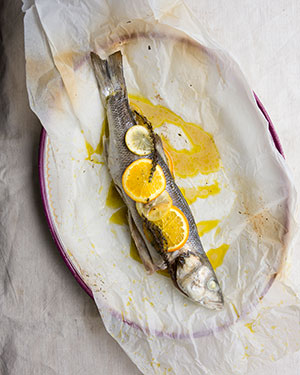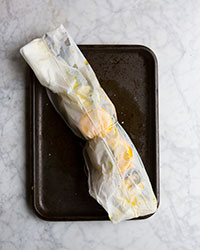Recipe: sea bass en papillote


Roula Khalaf, Editor of the FT, selects her favourite stories in this weekly newsletter.
A chef in France has banned his customers from taking pictures of his food, citing his “intellectual copyright”, among other things, as having been breached by the annoying habit of photographing the dish rather than breathing in its aroma, tucking in and talking to one’s companions. He has a point. But while I agree that the practice is silly, slightly rude and misses the point, I would never impose such a ban. It is their food and it is their meal that is being spoilt by dinner-table photography. Nevertheless, it is a worrying trend.
I blame the telly. Ever since food programmes stopped being fun and started taking food too seriously, the way a dish looks has become much more important than the way it smells or tastes.
I recently experienced this first-hand when confronted by a dish sculpted on a black rectangular plate in the shape of a tree. The leaves were a blossom of some ice-cold creamy emulsion that tasted of very little. Among the leaves were little spheroid charms in purple, green and orange with ever more bizarre flavours. At the base of the tree was a collection of little fruits of the forest which included mushrooms fashioned out of foie gras, shards of Iberico ham and some micro leaves. Not content with his work, the chef had directed the waiter to come over with a dredger and shower “snow” of dehydrated essence of some unintelligible substance over the ensemble. Still worried that he might have left something out, the chef himself came over and shaved some excellent but redundant truffles over the surface. Finally satisfied, he retired and I was free to savour the dish. It was visually arresting and tasted quite, quite repulsive.
The trouble is not just that chefs are in danger of wrong turnings if they only consider the visual in their food. There is a deeper problem. Food becoming pretty pictures is just another symptom, I fear, of our alienation from the process of food and our inability to deal with it.
I was recently in Hong Kong where it is considered poor form to buy dead fish – it is usually sold still flapping around in a tank – and chickens are often sold alive and dispatched in front of you. I am not suggesting that we should adopt or return to these practices but a little more connection with the feel of what we eat might be in order.
This is by way of a preamble to a dish that is something of an antidote to modern trends. It arrives at the table in a paper parcel and then has to be negotiated before it can be consumed free of bones. It is extremely simple to cook, looks like nothing at all and is, of course, aromatic, full of flavour and tastes of what it is. Pick the bones, as they say, out of that.
Rowley Leigh is the chef at Le Café Anglais
Sea bass en papillote
Ingredients
It’s refreshing to serve a recipe for sea bass without fennel, if only by way of a change.
Serves two.

1 good bass weighing at least 1kg
1 clove garlic
Several sprigs of thyme
1 anchovy fillet
1 orange
1 lemon
4 tbs very good olive oil
● Ensure that the bass is completely descaled and cleaned inside and rinse through with cold water. Smash the clove of garlic with the back of a knife and place it with some thyme, the anchovy fillet and a couple of strips of orange and lemon zest inside the belly cavity.
● Lay a large sheet of greaseproof paper, say 50cm square, on a board. Spread the olive oil liberally over the middle of the paper and sprinkle with a couple of teaspoons of sea salt. Place a slice of orange, a slice of lemon and a few sprigs of thyme one-third of the way up. Lay the sea bass over them, and top with another slice of lemon and orange, more thyme and a good sprinkling of ground black pepper.
● Carefully bring the bottom end of the paper over the fish and proceed to roll it up, keeping the fruit in place. Fold the ends over as though wrapping a parcel and secure with string.
● Sprinkle a few drops of water on to a tray, place the package on top and sprinkle it with a little more water. Put in a hot oven (200C) for 20 minutes. The fish should be cooked, depending on thickness: you can test with a skewer passed through the paper and fish, which will meet with minimal resistance.
● Take to the table and unwrap. Lift the top fillet off the bone and transfer to one plate. Lift away the backbone and transfer the second fillet to the next plate. Spoon the precious juices over each and serve. (The fruit gives its aroma and juice; it should not be eaten.)
——————————————-
Rowley’s drinking choice
The rich flavour of the fish and citrus aromas, especially orange, put me in mind of the heady scent and rich body of white wines from the southern Rhône. A white Châteauneuf du Pape, should you be lucky enough to have some, would be brilliant.
Comments